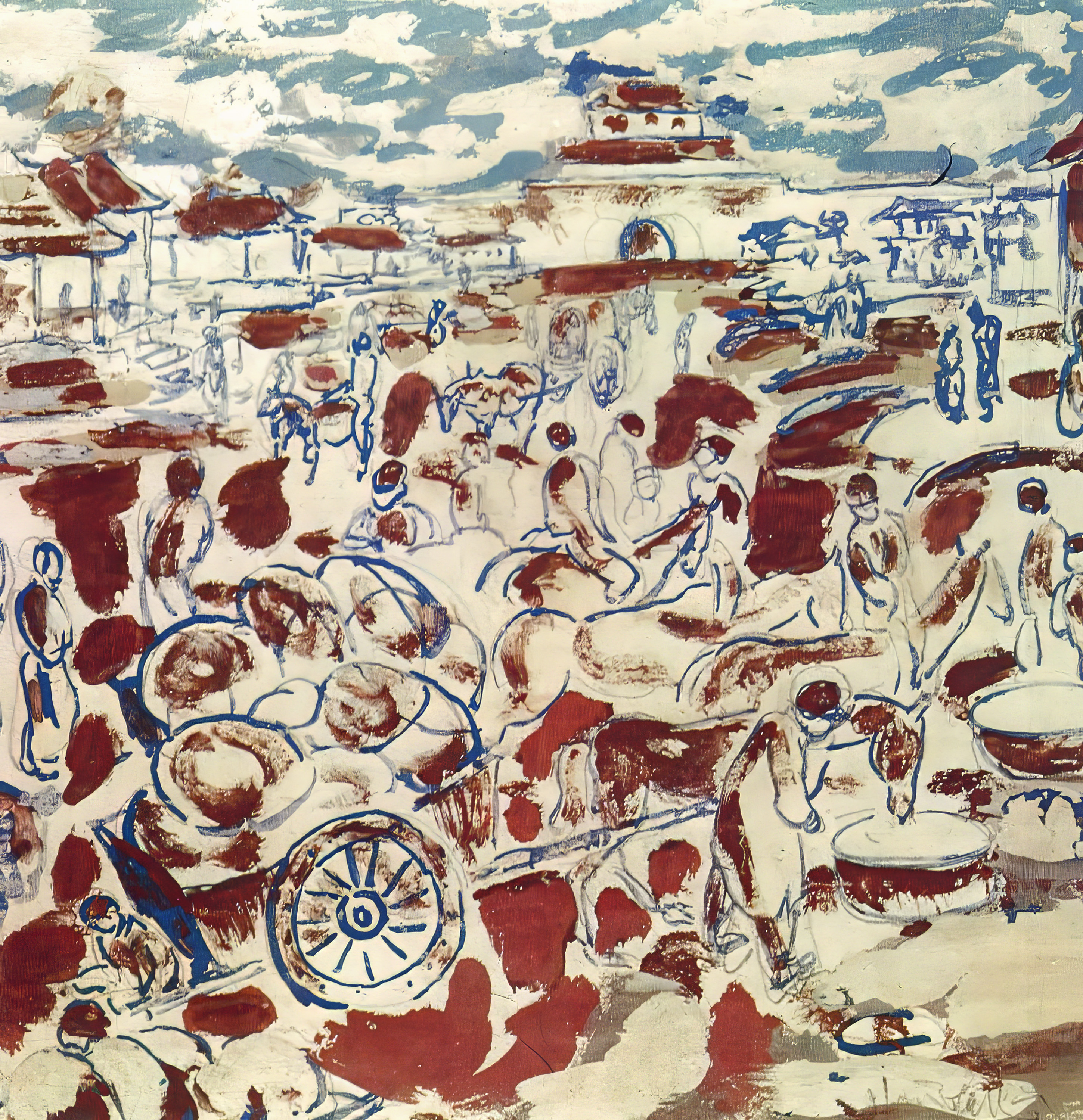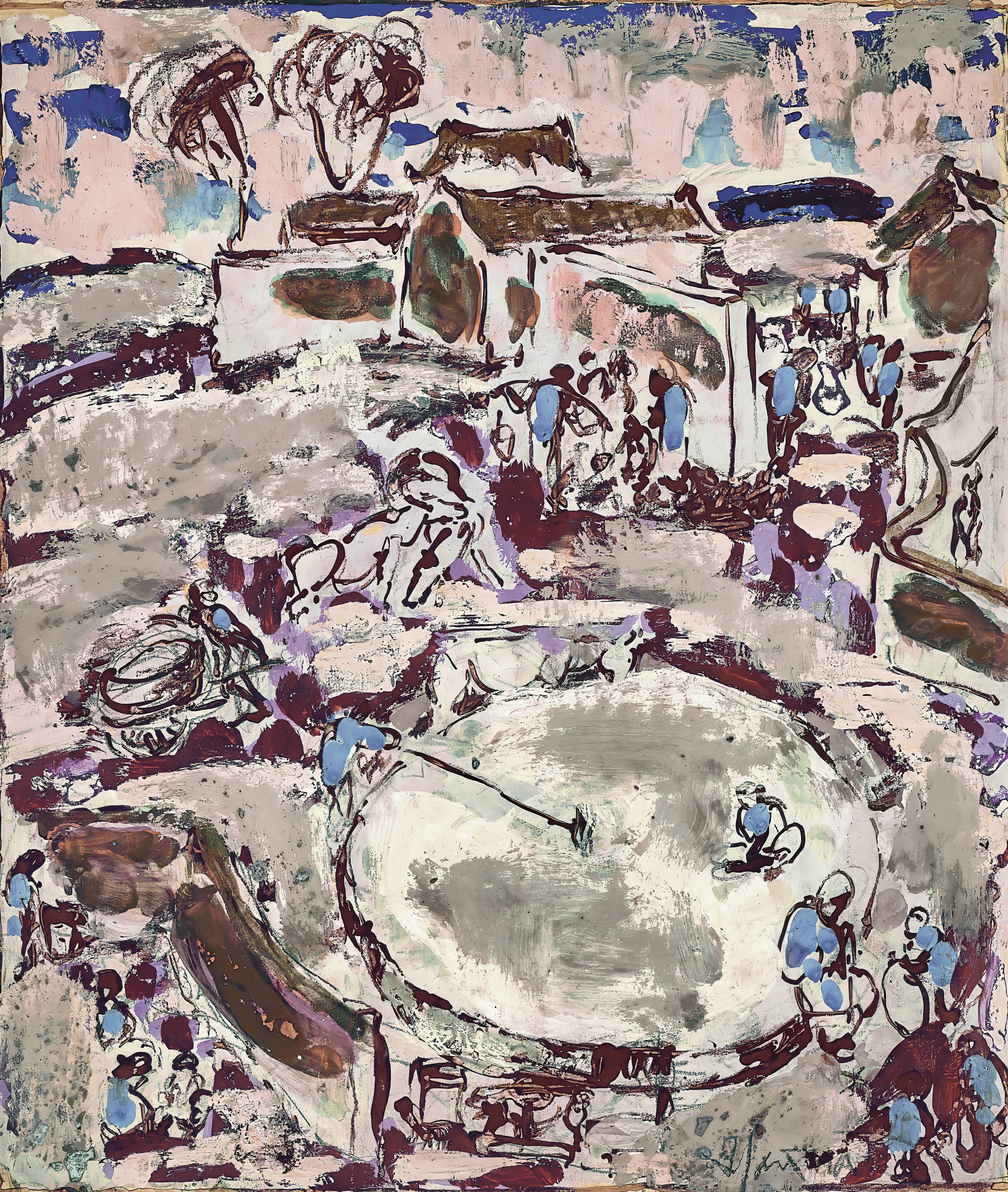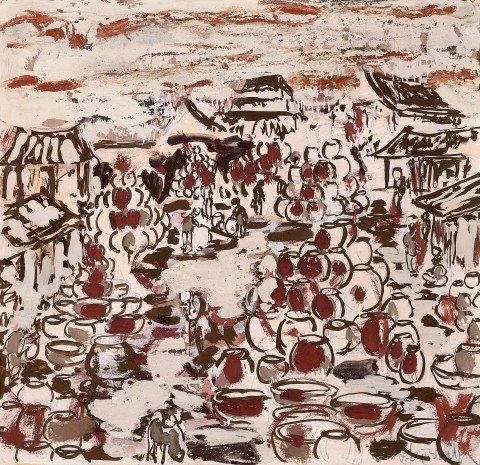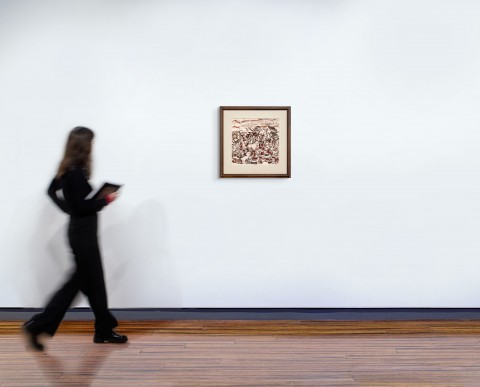MARKET SCENE, PEKING, c.1945
IAN FAIRWEATHER
gouache and pencil on paper
38.0 x 39.5 cm (image)
48.0 x 50.0 cm (sheet)
signed lower right: I. Fairweather
Isabella Griffiths, London
Thence by descent
Private collection
Christie’s, Melbourne, 3 May 2004, lot 85
Private collection, Melbourne
Probably: Paintings by Ian Fairweather, The Redfern Gallery, London, 28 October – 20 November 1948, cat. 23 (as ‘Market Foochow’)
Bail, M., Ian Fairweather, Bay Books, Sydney, 1981, cat. 63, fig. 29, pp. 75, 76, (illus.), 235 – 236;
revised edition, Murdoch Books, Sydney, 2009, cat. 57, pl. 44, pp. 70, 71 (illus.), 249 (as ‘(Market Scene, China)’)
Smith, R., ‘Ian Fairweather: artist of cosmological figuration’, Art and Australia, Sydney, vol. 21, no. 3, Autumn 1984, pp. 337 (illus.), 341
Horse-fair-Peking cmyk-topaz-denoise.jpg

In October 1947 Fairweather sent 130 gouaches to the Redfern Gallery in London, the second such consignment.1 They were painted while he was living at Lina Bryans’ house in Darebin which was a stable and productive time for the artist. The works were ‘ghosts’, Fairweather wrote to Jim Ede in the December, painted ‘in ten different ways’; he knew he could not move on with other subjects until they were put to rest. They were memories of the past, and Chinese market and street scenes of differing sizes – some according to Bail, ‘mixed with clag [and] very thickly painted.’2
Market Scene, Peking, 1945 – 47 depicts a crowded jumble of terracotta pots and bowls in stark browns and blacks over a background of creamy whites and greys. It hums with the chatter of stall holders and street sellers and is a work of such vividness and immediacy that it is hard to believe it was painted from memory.
The gouaches, which were packed by Fairweather, subsequently arrived at the Redfern Gallery ‘in one solid congealed mass’, not one being able to be saved, according to Redfern director, Rex Nan Kivell.3 They were bundled up and sent to Isabella Griffiths, Fairweather’s cousin whom he called Ella. She had married the distinguished gynaecologist and musician Walter Spencer Anderson (1854 – 1946) as his second wife, was close to Fairweather’s sister Ethel and lived at 19 Cheyne Walk, Chelsea. It was here that Fairweather stayed after being shipped back to London by the British Government following his disastrous raft voyage to Timor in 1952.
Cornsifting, Soochow (sup image)-topaz-denoise.jpg

He was destitute and accused Ella of storing the paintings so inadequately that they were riddled with mould and eaten by silverfish. In spite of this, Fairweather had little hesitation in accepting Ella’s hospitality. Nor did it stop him from criticising her food and lifestyle, or dropping cigarettes and mud throughout the house.4 They argued furiously, Fairweather burning all the gouaches kept at Cheyne Walk save for this painting which escaped the same fate, it has been suggested, after slipping down the back of the incinerator.5 More credibly, Ella probably salvaged the work when the bundle arrived from the Redfern Gallery as it shows no sign of significant damage. It could be one of the two works mentioned by Fairweather in a letter to his niece Pippa.6
Writing to Pippa in 1953, he said that ‘there were just two that for sentimental reasons I couldn’t bring myself to destroy’. He begged her to rescue them from Ella – and specifically, work that was ‘5ft by 3 ft’ on thick cardboard (clearly not the present Market Scene, Peking). The second painting is not detailed by Fairweather, but we know from the provenance that this work was owned by Isabella around this date.7
Ella accused Fairweather of being a ‘sponger…a hanger-on…a ne’er-do-well’.8 He was outraged. She was, he wrote, ‘a very [nasty] and poisonous old woman’ who had ‘forced him’ to burn the paintings as a way of humiliating him.9 Their relationship never recovered. Fairweather fled Cheyne Walk on 22 June 1953. He spent the day in the British Museum sitting in front of the Elgin marbles, writing plaintively to Pippa and waiting for the midnight train to Liverpool and the ship back to Australia.10
1. The first shipment of gouaches was sent in June 1946 and packed with the help of Lina Bryans; they were all stamped with an Australian customs stamp.
2. Bail, M., Ian Fairweather, Bay Books, Sydney, 1981, p. 75
3. Letter from Nan Kivell to Murray Bail, 22 July 1976. See Bail, ibid., p. 225, chapter 7, endnote 14. An earlier bundle sent in June 1946 were stamped by Australian customs to allow re-entry into Australia, see Bail, ibid., p. 74
4. Abbott-Smith, N., Ian Fairweather: A Profile of an Artist, University of Queensland Press, Brisbane, 1978, pp. 123 – 4
5. Bail, op. cit., p. 75
6. Letter 77, Ian Fairweather to Helga Macnamara (Pippa), 22 June 1953, cited in Roberts C., & Thompson, J., Ian Fairweather: A Life in Letters, Text Publishing, Melbourne, 2019, p. 139. As other letters by the artist show, he was quite paranoid at this time.
7. Letter 77, cited ibid.
8. Abbott-Smith, op. cit., p. 124
9. His complaints about Ella reveal that at the age of 66, she was newly widowed (Walter died in 1946) and she was dealing with a very large house without the help of any servants. In February 1974, she was stabbed to death by an intruder.
10. His passage was paid by his siblings after Fairweather ‘passed the hat around’, see Abbott-Smith, op. cit., p. 125
DR CANDICE BRUCE


